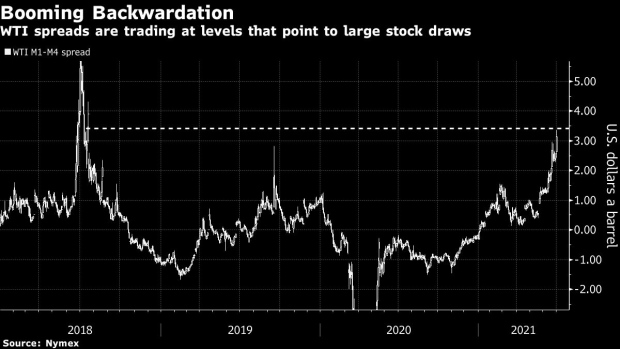Jul 1, 2021
Runaway Oil Spreads Flash Warning for U.S. Crude Inventories
, Bloomberg News

(Bloomberg) -- The U.S. oil futures curve is pointing to a tightness the market hasn’t seen in years, sparking concerns of the potential for sharp inventory drawdowns.
The three nearest so-called timespreads on the West Texas Intermediate futures curve hit $1 a barrel or more on Thursday. That’s an indicator that the market is growing increasingly worried about supply tightness, particularly at the key storage hub of Cushing, Oklahoma, where U.S. crude futures are priced.
WTI for immediate delivery is more than $3 higher than delivery for four months ahead, the widest spread since 2018. The last time the spreads were this strong, inventories at the key U.S. hub were just slipping below 25 million barrels, about 15 million below their current level. The bullishness has steadily rippled along the forward curve, increasing market angst in recent days.
The U.S. remains the hottest corner of the oil market, as a steadily reopening economy is pushing refiners ramp up their crude processing. In the Midwest region, where Cushing is located, refiners were operating at about 98% of capacity last week, while the nationwide figure was about 93%.
All the while, the U.S. continues to export bumper levels of crude, also helping drain domestic inventories and producers are keeping a lid on production. Stockpiles have been falling at the fastest rate in decades, something that shows little sign of abating if the current export trend continues.
The potential for limited action by OPEC+ on Thursday is also compounding expectations of supply tightness in the coming months. The group is expected to add 400,000 barrels a day to the market in August, but that’s a fraction of it’s own estimates for the global market deficit over the period.
©2021 Bloomberg L.P.


